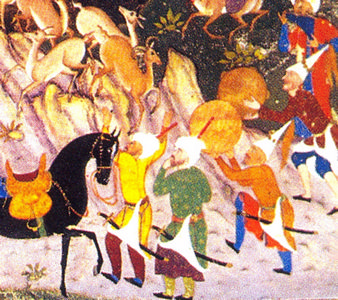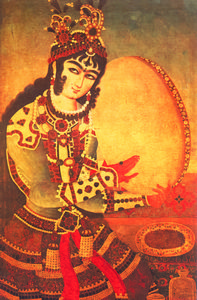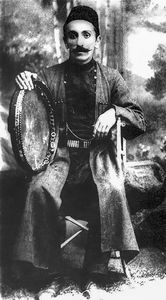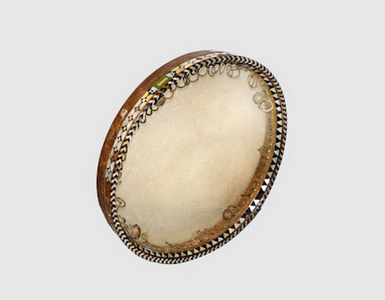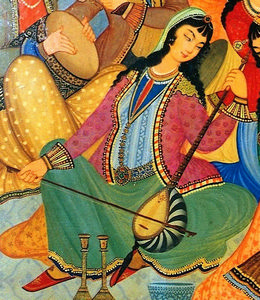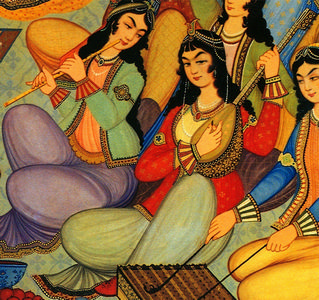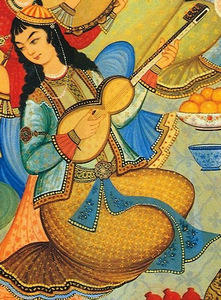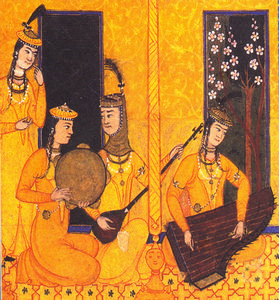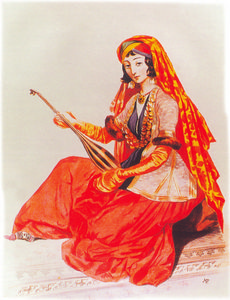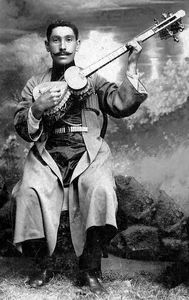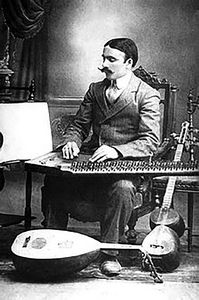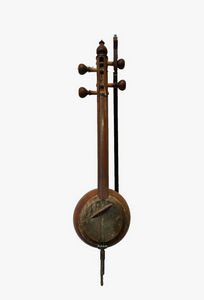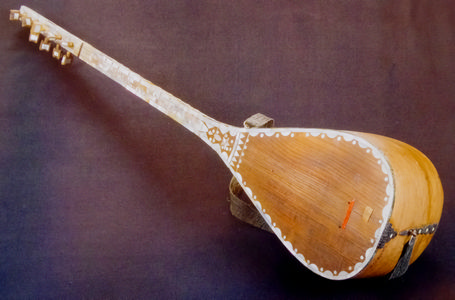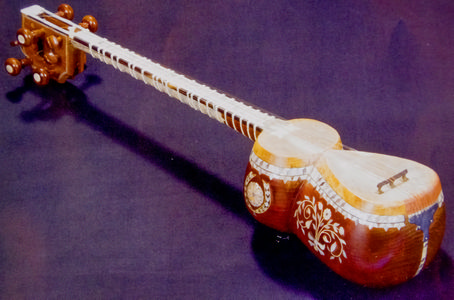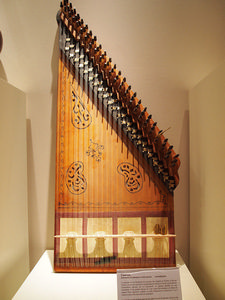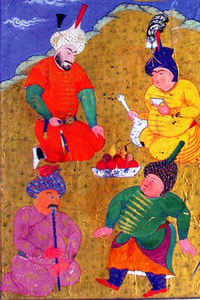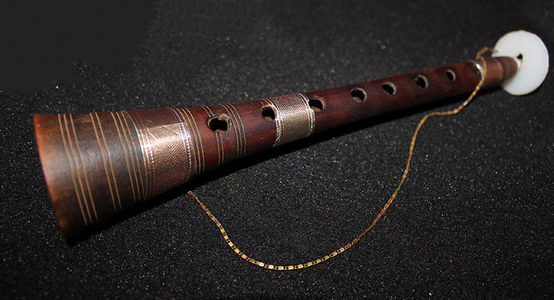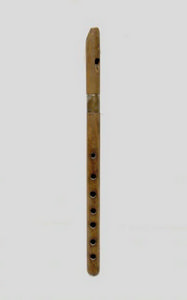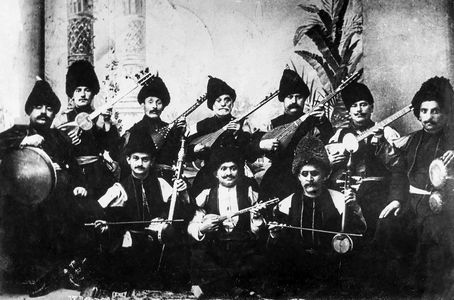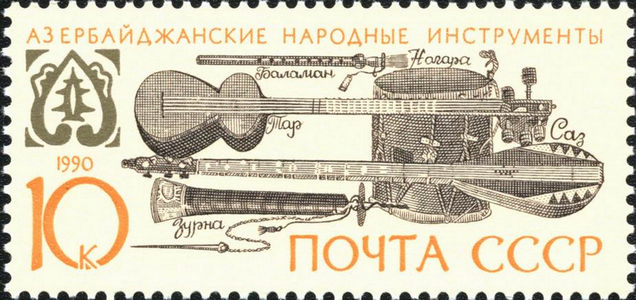Percussion instruments
Qaval (Daf)
Qaval is a percussion instrument of Azerbaijan. It is one of the rare musical instruments that has remained unchanged from ancient times to the present day.
To make qaval (frame drum), sturgeon skins were applied on its rim. 60-70 copper rings are attached to the rim, which make a rattling sound. The drum is an absolute instrument for performers of tasnif and mugham.
Naghara (Drum)
The Naghara (drum) is a percussion instrument of Azerbaijan. There are large, medium and small types of nagharas according to their size. The cylindrical naghara is called an "armpit naghara". One or two hands are used on the naghara, and in some samples of folklore 1-2 wooden sticks are used. The naghara is used in rhythmic dances, traditional folklore games and staged folk games.
Qosha-naghara
Qosha-naghara (double drum) is a percussion instrument of Azerbaijan. It was made of two combined bowl-shaped nagharas. They play on a qosha-naghara with two wooden sticks. Folk instruments are part of ensembles and orchestras, played at weddings, as well as used in the performance of Azerbaijani folklore.
String tools
Kamancha
Kamancha is a string musical instrument of Azerbaijan. It is used not only as an absolute instrument in professional traditional mugham ensembles, but also as a solo instrument. The Azerbaijani kamancha consists of a bowl, an arm and a shaft. The shaft connects the arm to the bowl and acts as a support by protruding from the bowl. The German traveler E. Kaempfer (XVII century) described the Azerbaijani kamancha as a three-stringed and sometimes four-stringed instrument with a beautiful sound.
Saz
Saz is a stringed musical instrument of Azerbaijan. It is a traditional musical instrument of Azerbaijani ashigs. According to experts, saz is based on "Shirvan's tanbur ", and before that "qopuz" mentioned in the epos "Kitabi-Dada Gorgud". The saz instrument was described in the works of classic poets, including the works of the great Azerbaijani poet Nizami Ganjavi (XII century).
The saz consists of pear-shaped bowl, 8-9 ashikhs on the top of the arm, a wooden resonator (strings), and wires. Saz is a stringed instrument played with tezene (mizrab) (pick). It is able to be performed both solo and in ensembles.
Tar
Tar is a stringed musical instrument of Azerbaijan. Azerbaijani tar is fundamentally different from tar forms common in other Eastern countries. The two-part bowl of Azerbaijani tar is connected to a long arm. It has 11 strings (for example, the number of strings in the Iranian tar is 6). The author of the improved tar is connected with the name of the Azerbaijani inventor-musician Sadiqjan (Mirza Sadiq Asad oglu, 1846-1902), known as the "father of tar". In Azerbaijani music, tar is used as a leading instrument in the mugham trio. In the early twentieth century, in Azerbaijan emerged a new genre - "mugham opera". In all works of this genre, vocal parts were accompanied by tar. In 2012, the performing art with Azerbaijani tar were included in the UNESCO list of intangible culture
Qanun
Qanun is a stringed musical instrument. The Azerbaijani qanun is reminiscent of a flat wooden box with different angles at the sides. This qanun differs from the Turkish, Arab, and other canons. It is used as an accompaniment and solo instrument in orchestras and ensembles of folk instruments. The qanun instrument was described in the works of many Eastern poets, including Azerbaijani poets Nizami Ganjavi, Mahammad Fuzuli, Mahsati Ganjavi.
Azerbaijani composer Uzeyir Hajibeyli noted: "If today it is important for every musician to play the piano, Eastern musicians who used to play various musical instruments in the past should be able to play qanun."
Woodwind instruments
Balaban
Balaban is a woodwind musical instrument of Azerbaijan made from wood. It is in the form of a tube with nine holes. In the ancient settlement of Mingachevir has been found a woodwind instrument made of bone, the prototype of the balaban dating back to I century B.C.
The meaning of the word "balaban" is related to the words "bala" (small) and "ban" (the timbre is similar to the rooster's ban – crow), and means "small ban" (first, early crow). The balaban, which has soft and melancholy sound, is used to accompany a group of wind instruments, such as ensemble, orchestra and solo instrument, as well as a group of ashigs.
Zurna
Zurna is a woodwind musical instrument of Azerbaijan. It is believed that zurna (from the word "sunray") literally means "holiday's, feast's ney (reed pipe)." A pair of tongs is attached to the head of the body, shafts made of bronze, copper or silver plates are attached to the tongs. During archeological excavations in Mingachevir, one of the ancient human settlements, four zurnas made of deer horn were found. Scientists estimate that these instruments are 3,000 years old. The zurna players perform mainly in the ensemble of woodwind instruments. Tutek is also used as a solo instrument in ensembles and orchestras of folk instruments, performing some dances, jangi (fights) and other musical samples.
Tutek
Tutek is an ancient wooden musical instrument of the flute type of Azerbaijan. It is in the form of a tube with six-seven holes in the upper part, one hole in the bottom. In the past, it was made of reeds, bones, wood, pottery, etc. It is believed that, shepherds and herdsmen were the first to invent and express it in the past. In Azerbaijan, different types of tuteks are mainly used as solo instruments in ensembles and orchestras of folk instruments. Currently, the most complex songs, dance tunes, and even program instrumental plays are perfomed with tutek. In ancient miniatures, potteries, as well as in the works of classic poets (Nizami, Fuzuli, etc.), the description of tutek – ney is reflected in the examples of oral folk art.
